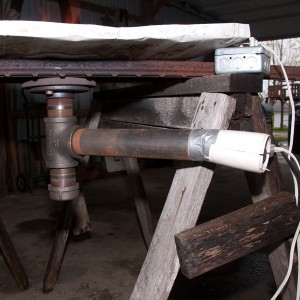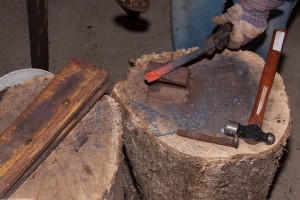For some time now, Don has had an interest in blacksmithing. He and Mason have even made a trip to south Missouri for an overnight workshop. It wasn’t long after returning that Don started forming the idea of making his own forge of sorts and began gathering and repurposing materials from around our farm.
 Using saw horses and t-posts as a base, Don placed a sheet of roofing metal on top of it with a disk brake rotor in the center to contain the coal fire used to heat the metal being shaped. Two inch black pipe was attached via a flange to the bottom of the rotor to channel the air to the fire and this air flow is created by an old hair dryer which has had the heating element removed. Don even incorporated a lighting dimmer switch to control the air velocity while the dryer is on.
Using saw horses and t-posts as a base, Don placed a sheet of roofing metal on top of it with a disk brake rotor in the center to contain the coal fire used to heat the metal being shaped. Two inch black pipe was attached via a flange to the bottom of the rotor to channel the air to the fire and this air flow is created by an old hair dryer which has had the heating element removed. Don even incorporated a lighting dimmer switch to control the air velocity while the dryer is on.
 Of course the anvils are make-shift as well. Using a downed tree to make two waist-high support stands, Don carved out a portion in the center of each. In one he fitted a section of road grader blade complete with a hardy hole and the other stand was fitted with a piece of railroad track. Don continues to look for an actual anvil.
Of course the anvils are make-shift as well. Using a downed tree to make two waist-high support stands, Don carved out a portion in the center of each. In one he fitted a section of road grader blade complete with a hardy hole and the other stand was fitted with a piece of railroad track. Don continues to look for an actual anvil.
Starting off, Don has made some simple tools for campfire cooking and brackets for an improvised curtain rod. Thanks, Honey.
Blacksmithing is an interesting craft and skill. It brings to mind words such as durable and strong, primitive yet useful and long-lasting. Early cultures who knew how to heat and shape iron had definite advantages over those that used stone. Until the Industrial Revolution, blacksmiths were an intricate part of every community. They crafted farm implements, tools, nails, barrel hoops, locks, horse shoes and hardware just to name a few items used every day. Today, it seems to be more of an artisan avenue for making decorative ironwork.